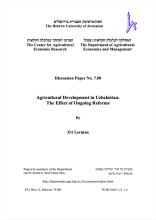/ library resources
Showing items 1 through 9 of 34.This is the first results-based country strategic opportunities programme (RB-COSOP) for the country, and covers the period 2017-2021.
Cotton production substantially contributes to the GDP of Uzbekistan. It is produced under a state procurement policy, according to which farmers have to allocate half of their land for cotton, fulfill cotton output levels and sell the entire harvest of cotton to the state.
In this article we investigate the potential for and limitations of land consolidation as a tool for rural development in transitional environments, focusing on the Khorezm region in Uzbekistan, Central Asia.
Gender equality is a key to eliminating poverty and hunger, as it has been demonstrated by the FAO throughout its research worldwide.
This country case study summarises key findings from a country analysis of financing for rural development in Uzbekistan. It is one of 20 analyses that is synthesised for comparison in Prizzon et al. (2020).
The case study has two main objectives:
FIRST PARAGRAPH OF CHAPTER: Uzbekistan emerged as an independent state in September l99l with a legacy of an undiversified monocultural agriculture heavily specialized in cotton.
Agricultural transition in Uzbekistan, as in all CIS countries, is driven by a process of land reform, which involves redistribution of land among producers and concomitant changes in farm structure.
In January 2019, Uzbekistan started a new farm restructuring1. It is said to seek to optimize the use of farmland by increasing the size of farms producing wheat and cotton, reallocating land to more efficient farmers and even clusters, and improving crop rotation options.
The present Agreement is applicable to expropriated land, including arable land, pastures and land for waterworks, pertaining to Abumuhar and Karsh irrigation channels, and Tuymuyun water reservoir that have been conceded to the Parties on condition of joint permanent land tenure.
Pagination
Land Library Search
Through our robust search engine, you can search for any item of the over 73,000 highly curated resources in the Land Library.
If you would like to find an overview of what is possible, feel free to peruse the Search Guide.









